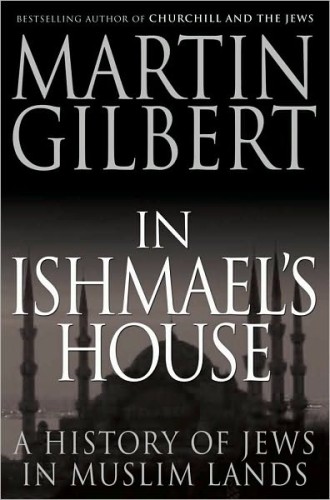In Ishmael’s House, by Martin Gilbert
Sir Martin Gilbert, an author of many books, has written an argument for one of the silent participants in the Israeli-Palestinian conundrum. He recounts the story of the Jewish experience under Muslim rulers over the past 14 centuries, an ambitious task that necessitates wide reading among numerous specialties. Gilbert draws on this scholarship to present a general overview of the long tradition that preceded the 19th- and 20th-century vicissitudes of the Jews who are scattered throughout the Dar al-Islam, which extends from Morocco to India and from the steppes of southern Russia to southern Arabia. His story gains greater authority with his own research and his interviews with 20th-century refugees from these areas.
Gilbert notes that when things went well in both the broader and local Islamic world, the dhimmis (protected monotheistic minorities) fared well under the limitations dictated by Shari'a law. When things soured, the dhimmis were the first victims of increased tensions. Aside from the vicissitudes of the first millennium of Islamic history, the general decline of the Islamic world in the face of European aggression in the 19th and 20th centuries exacerbated Muslim pride and led to the ill treatment of dhimmis, in particular the Jews, who had no outside protector as did the dhimmi Christians. As they were abandoned by the West, the Christians also suffered discrimination and unacceptable pressures that threatened even their survival in the Arab world, especially in the holy cities of Palestine, such as Bethlehem. A case in point is the xenophobic expulsion of the Greek Orthodox from Egypt and Turkey.
With the shock of World War I, the fragile unity of the Arab world disintegrated, as did loyalty to the caliphate, which was soon to be abolished by the revolutionary program of Turkey's Kemal Ataturk. The emergence in the late 19th century of a Zionist settlement that was recognized by the Western (Christian) victors invigorated the religious leadership of the Muslim masses, who rejected British control of their lands by attacking its weakest link—the Jews, whom Britain had more or less protected from 1840 to 1940. Jews in Islamic lands were harassed, robbed and murdered, and pogroms were carried out against them in the name of anti-Zionism.
Gilbert describes the fate of some 800,000 Jews forced to leave their millennial homes and lands, their friends and their businesses and the bones of their ancestors, their holy places and ancient sanctuaries in the wake of the establishment of the state of Israel. The areas abandoned by Palestinian Arabs were filled by these refugees, many of whom had immigrated during the declining years of the Ottoman sultanate and the decades of the British Mandate as a result of the controlling powers' policy of offsetting the increasing number of Jews and chiliastic Christians from Germany, Sweden, the United States and other places. These "Arab" Jews have been more or less integrated into Israel's multiethnic society and now number more than 60 percent of Israel's population. Their memory of loss and frustration has in the past generation become an important factor in Israel's internal politics.
The plight of the Jewish refugees from Arab lands—and their compensation—is thus a legitimate card on the negotiating table in the Arab-Israeli dispute. This is the well-argued thesis of Gilbert's book, and he illustrates it with numerous individual memories. Gilbert has written a useful and relatively popular addition to a growing body of scholarly and legal literature on the plight of the Arab Jews who were displaced in the mid-20th century. This is a must read for those who are interested in an intelligent survey of a little-known facet of the refugee problems that have beset Jewish societies in the past three generations.





